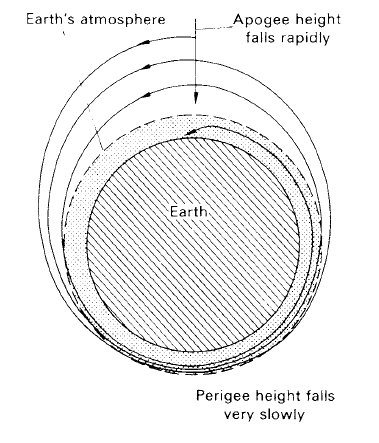


 الفيزياء الكلاسيكية
الفيزياء الكلاسيكية
 الكهربائية والمغناطيسية
الكهربائية والمغناطيسية
 علم البصريات
علم البصريات
 الفيزياء الحديثة
الفيزياء الحديثة
 النظرية النسبية
النظرية النسبية
 الفيزياء النووية
الفيزياء النووية
 فيزياء الحالة الصلبة
فيزياء الحالة الصلبة
 الليزر
الليزر
 علم الفلك
علم الفلك
 المجموعة الشمسية
المجموعة الشمسية
 الطاقة البديلة
الطاقة البديلة
 الفيزياء والعلوم الأخرى
الفيزياء والعلوم الأخرى
 مواضيع عامة في الفيزياء
مواضيع عامة في الفيزياء|
Read More
Date: 3-9-2020
Date: 2-9-2020
Date: 28-2-2016
|
Effect of the Earth’s atmosphere on a satellite orbit
If any part of a satellite orbit lies within the Earth’s atmosphere, the satellite experiences a drag force that is a function of the cross-sectional area of the satellite, its velocity and the air-density. Even at the height of 200 km, where the air-density is less than that in a good laboratory vacuum, the drag will be sufficient to bring the satellite spiralling in slowly to the deeper and denser layers of the atmosphere. The process is then accelerated: the satellite loses energy (kinetic plus potential) more swiftly until it plunges into air dense enough to burn it like a meteor. A typical orbital evolution is shown in figure 1.

Figure 1. The evolution of a satellite’s orbit due to atmospheric drag.
It is found that apogee height falls more rapidly than perigee height. Indeed, the apogee may change by hundreds of kilometres while the perigee changes by under ten kilometres. Because velocity in an elliptic orbit is greatest when the satellite is nearest its primary, and because drag is proportional to the square of the velocity, most orbital change in a revolution is caused at or near perigee. This, together with the near-constant perigee height in a satellite orbit, is an opportunity to measure and monitor the air-density at a particular height over many months. The many hundreds of satellites in orbits of different perigee heights, therefore, provide an excellent system for building up knowledge of the rate of change of air-density with height above the Earth’s surface. Daily changes, seasonal changes and changes that occur due to complicated solar–terrestrial relationships can also be studied in this way.
Fortunately, orbital changes due to the air-drag are different in character to those caused by the Earth’s departure from a sphere.
The inclination and right ascension of the ascending node are unaffected; the argument of perigee and the time of perigee passage suffer periodic changes. As we have seen before, not only do the semi-major axis and eccentricity vary periodically but they decrease secularly. The rate of decrease of semi-major axis, a, is best found by measuring the rate of decrease of the satellite’s period of revolution T .
We have,

where, in this case, μ = GM, M being the mass of the Earth.
Then a knowledge of T gives a value for a.
Formulas exist relating the drag force to the rate of change in the semi-major axis. Knowing the satellite’s velocity, size and mass, a calculation provides the air-density.



|
|
|
|
للعاملين في الليل.. حيلة صحية تجنبكم خطر هذا النوع من العمل
|
|
|
|
|
|
|
"ناسا" تحتفي برائد الفضاء السوفياتي يوري غاغارين
|
|
|
|
|
|
|
مهرجان تعزيز الذاكرة الأول يشهد افتتاح معرض خاص بجرائم الإبادة الجماعية
|
|
|